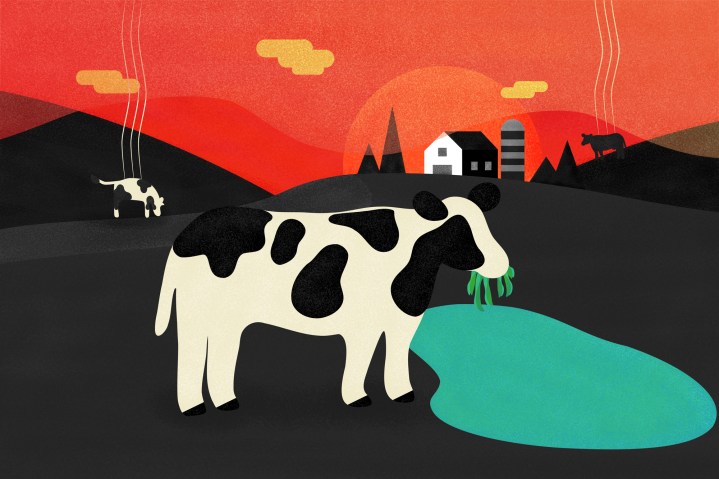
There are a lot of reasons your favorite beef burger isn’t great for the environment. Cattle take up a lot of space and consume a lot of food, and growing, processing, and transporting it all causes greenhouse gas emissions.
Alexia Akbay isn’t trying to solve all those problems. With her startup, Symbrosia, she just wants cows to make cows less gassy. The solution, she says, is seaweed.
In the U.S., the agricultural sector contributes to about 10% of the total greenhouse gas emissions, and a quarter of that comes from the methane produced by livestock digestion. While overall that may not sound like a significant contributor to greenhouse gases, methane is more potent than carbon dioxide, trapping more heat.
While it may be fun to blame cow farts for methane in the atmosphere, it’s actually the animals’ burps that release most of the gas. As a normal part of ruminants’ (cows, goats, sheep, and so forth) digestion, microorganisms in their guts produce methane as a byproduct. Researchers have shown that some additives, when mixed into their usual diets, can inhibit the production of methane in the animals’ stomachs. There’s a particular type of seaweed that appears to do the trick. “It produces a metabolite as a defense mechanism that essentially creates the methane reduction in the stomach of the ruminant,” Akbay told Digital Trends.
“Replacing 0.5% of cattle’s feed with an a. taxiformis supplement could reduce up to 80% of emissions.”
With its rusty red color, Asparagopsis taxiformis can make an eye-catching contrast to the seafloor. The red seaweed grows in temperate waters, in parts of Asia and Australia. It’s found a few places the U.S., including Southern California, the Florida Keys, and Hawaii. At the Natural Energy Laboratory of Hawaii Authority, Akbay is looking at ways of scaling up the seaweed’s production, so it can be sustainably and profitably sold to farmers.
Significantly reducing the amount of methane cows expel doesn’t take that much algae. Researchers at Penn State University found that replacing 0.5% of cattle’s feed with an a. taxiformis supplement could reduce up to 80% of emissions. Symbrosia’s mix is meant to replace 0.2% of animals’ feed. When researchers tried adding the algae at higher levels, they’d have to add molasses as well, to balance out the plant’s saltiness, Akbay said. During a trial of Symbrosia at a farm in New York, the sheep didn’t seem to mind the dusting of algae in their feed, she said.

Getting animals used to even a small change in their meals can take time, according to Akbay. “A lot of the time, the process for onboarding a new material into the diet of the animal can take a week to two weeks and has to be implemented by someone that they trust,” she said. The company’s next trial will be in mid-2021, with cattle.
In the meantime, Akbay is working on scaling production. The seaweed grows quickly, but it needs to be dried and milled as well. “The issue quickly becomes providing the amount of seaweed that will even begin to tackle this problem,” she said. Cattle eat an enormous amount of food, and the amount depends on a variety of factors — like time of year, their weight, and whether they’re pregnant, but a 1,100-pound dairy cow might need around 22 pounds of dry feed. You’d need less than an ounce of the algae a day for that one cow, but there are 1.4 billion cattle in the world. It adds up.
While the seaweed doesn’t need much beyond seawater and sunlight to grow, it’s potentially an invasive species that can’t just be introduced into a new environment. Taking it from an ecosystem where it already grows is also a problem. California’s coast is already grappling with the growth of the edible seaweed industry.
Despite the complexities, Akbay still thinks it’s an idea worth pursuing. “I’d really like to encourage people to start working on harder solutions,” she said. “The world needs more people, more hands on deck, more doers.”


